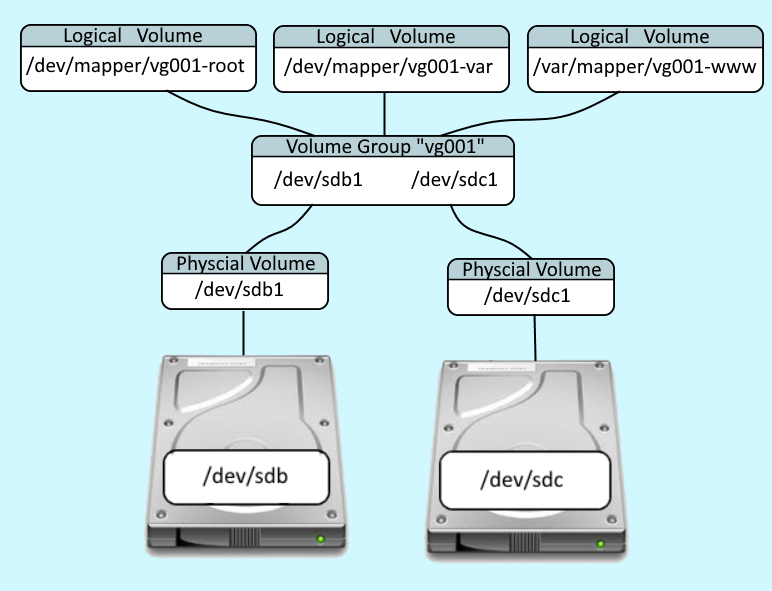
LVM (Logical Volume Manager) is a system that lets you create logical volumes from physical storage devices. For example, in this illustration, using 2 physical storage devices, 3 logical volumes are created:
- /dev/mapper/vg001-root
- /dev/mapper/vg001-var
- /dev/mapper/vg001-www

The first step in setting up an LVM system is to create a partition on each physical storage device to use the Linux LVM system. This can be accomplished with fdisk, gdisk, or parted. Here are the steps on how to set /dev/sda3 to type Linux LVM using parted.
parted -s /dev/sdb set 1 lvm on
parted -s /dev/sdc set 1 lvm on
The pvdisplay command should now show both physical volumes. Or, the pvcreate command can be used to create the physical volumes.
--- NEW Physical volume ---
PV Name /dev/sdb1
VG Name
PV Size <100.00 GiB
Allocatable NO
PE Size 0
Total PE 0
Free PE 0
Allocated PE 0
PV UUID qIJr3I-uokW-qIRJ-Mi9a-SmIp-2DYN-XwxUDf
--- NEW Physical volume ---
PV Name /dev/sdc1
VG Name
PV Size <100.00 GiB
Allocatable NO
PE Size 0
Total PE 0
Free PE 0
Allocated PE 0
PV UUID bW0moV-MWxi-4PvP-RWXR-NUFe-GfJD-2fe83A
Next you would use the vgcreate command to add the physical volumes to a volume group. In this example, the name of the volume group is "vg001".
vgcreate vg001 /dev/sdb1 /dev/sdc1
Or, if the volume group already exists, the vgextend extend command would be used.
vgextend vg001 /dev/sdb1
The vgdisplay command can then be used to display the volume group.
--- Volume group ---
VG Name vg001
System ID
Format lvm2
Metadata Areas 1
Metadata Sequence No 3
VG Access read/write
VG Status resizable
MAX LV 0
Cur LV 2
Open LV 2
Max PV 0
Cur PV 1
Act PV 1
VG Size <15.51 GiB
PE Size 4.00 MiB
Total PE 3970
Alloc PE / Size 3960 / <15.47 GiB
Free PE / Size 10 / 40.00 MiB
VG UUID lgHh9m-9iMP-8ltU-2cxz-Y4wL-uwG0-EHiGFr
Then the lvcreate command is used create logical volumes from available space in the volume group.
lvcreate --size 1G --name root vg001
lvcreate --size 1G --name var vg001
lvcreate --size 1G --name www vg001
The lvdisplay command can then be used to display each logical volume.
---Logical volume---
LV Path /dev/vg001/root
LV Name root
VG Name vg001
LV UUID EuBJ3c-Q8EU0M5ef-Qvip-KeyH-m2Sc-MGelKe
LV Creation host,time localhost.localdomain, 2013-10-11 15:40:12 -0500
LV Status available
# open 1
LV Size 99.94 GiB
Current LE 3198
Segments 3
Allocation inherit
Read ahead sectors auto
- currently set to 256
Block device 253:9
---Logical volume---
LV Path /dev/vg001/var
LV Name var
VG Name vg001
LV UUID EuBJ3c-Q8EU0M5ef-Qvip-KeyH-m2Sc-MGelKe
LV Creation host,time localhost.localdomain, 2013-10-11 15:40:12 -0500
LV Status available
# open 1
LV Size 99.94 GiB
Current LE 3198
Segments 3
Allocation inherit
Read ahead sectors auto
- currently set to 256
Block device 253:9
---Logical volume---
LV Path /dev/vg001/www
LV Name www
VG Name vg001
LV UUID EuBJ3c-Q8EU0M5ef-Qvip-KeyH-m2Sc-MGelKe
LV Creation host,time localhost.localdomain, 2013-10-11 15:40:12 -0500
LV Status available
# open 1
LV Size 99.94 GiB
Current LE 3198
Segments 3
Allocation inherit
Read ahead sectors auto
- currently set to 256
Block device 253:9
The mkfs command would then be used to configure each logical volume with a file system type.
mkfs --type xfs /dev/vg001/root
mkfs --type xfs /dev/vg001/var
mkfs --type xfs /dev/vg001/www
The file command with the --special-files and --dereference flags can then be used to validate each logical volume has the expected file system type.
~]# file /dev/vg001/root --special-files --dereference
/dev/vg001/root: SGI XFS filesystem data (blksz 4096, inosz 256, v2 dirs)
Finally, you would update the /etc/fstab so that the logical volumes are mounted at boot. In this example, the /etc/fstab would probably have something like this.
/dev/mapper/vg001-root / xfs defaults 0 0
/dev/mapper/vg001-var /var xfs defaults 0 0
/dev/mapper/vg001-www /www xfs defaults 0 0
Did you find this article helpful?
If so, consider buying me a coffee over at 